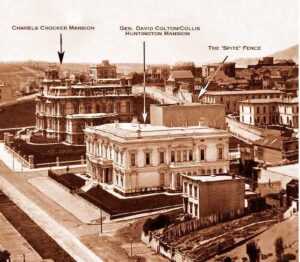San Francisco Tour Tales
Crocker’s Spite Fence

California Street, taken from Mark Hopkins’ home. The Crocker mansion is the building on the left of the photo, the spite fence is seen in back of the middle building.
If you look up “spite fence” on Wikipedia you will read: “A spite fence is an overly tall fence typically constructed between adjacent lots by a property owner who is annoyed with, or wishes to annoy, a neighbor or who wishes to completely obstruct the view between lots.”
Just below the definition you see a picture of the top of Nob Hill before 1906 that includes one of the most famous (or shall we say infamous?) spite fences ever built.
The story has been told a number of ways, but generally goes like this.
Charles Crocker, one of the “Big Four” partners in the Central Pacific Railroad, had become a multi- millionaire and wanted to build a mansion at the top of Nob Hill. Two of his partners in the railroad, Leland Stanford and Mark Hopkins, had already built large mansions and Crocker wanted to follow suit with one that he hoped would give him bragging rights on the hill. The Stanford mansion was the first one built, and the Hopkins mansion was by far the largest. Those two were next door to each other on the same city block (California St, between Powell and Mason). So Crocker wanted to buy a full city block and put one house on it. That way, even though smaller than the Hopkins mansion, he thought he would “trump” them.
Crocker began to buy up all the lots on the block as anonymously as possible and was quite successful for a while, but word finally got out. There was one holdout, a well-to-do gentleman named Nicholas Yung. Yung was an undertaker in the City below and had built a small cottage on the hill for his family years before.
The story then splits into two differing points of view. On the one hand, you have a millionaire bullying a small guy and trying to force his will. On the other hand, you have a story of an opportunist trying to take advantage of someone wealthy and take him for all he is worth.
In going through contemporary accounts from old newspapers, I came across an article that I think provides the most details of the story. It was printed in the Lima Ohio Times on January 20, 1888 as a reprint from an unnamed San Francisco paper.
According to the newspaper, Crocker offered Yung $6,000 for the piece of land. Yung agreed in principle, but when the courier arrived with the check, Yung upped the price to $9,000. Crocker was upset, but agreed and sent another check. Yung then upped the price to $12,000, and further added, “If he doesn’t accept, tell him I’ll start building coffins in my back yard so he sees them from his bedroom window!” Well, this was much too much for Crocker and he lost all interest in buying the property. Instead, he came upon the idea of fencing it in as tightly as possible. Crocker is quoted as saying, “I’ll seal him in as if he was in one of his own coffins!”
Crocker then hired railroad engineers to mount a fence some 40 feet high, walling in three sides of the house. Since Yung did not have the corner lot, the house only got direct sunshine about two hours a day. This was too much for Yung, and he soon moved the house to another property he owned, but he refused to sell Crocker the property as long as he lived.
A story is also told, perhaps apocryphally but a great story nonetheless, that Yung did mount a coffin showing over the wall with a skull and crossbones and the phrase, RIP C.C., on it.
The wall finally came down in 1904, when the heirs of both families finally settled the dispute. If they had waited a couple of years, the fire would have saved them effort, but at least there were two years when one could see Crocker’s original vision of the block, even if he himself was long gone.
Today the property is the site of Grace Cathedral. It’s quite an irony that one of our most sacred buildings graces the site of such a rancorous dispute. If you visit the street today, near the corner of Taylor and Sacramento, you can see two granite stripes in the sidewalk, just west of the corner. Those stripes are all that remain of the Crocker spite fence.







